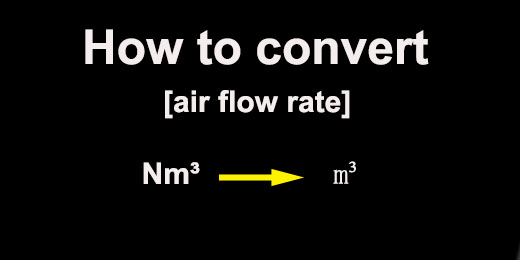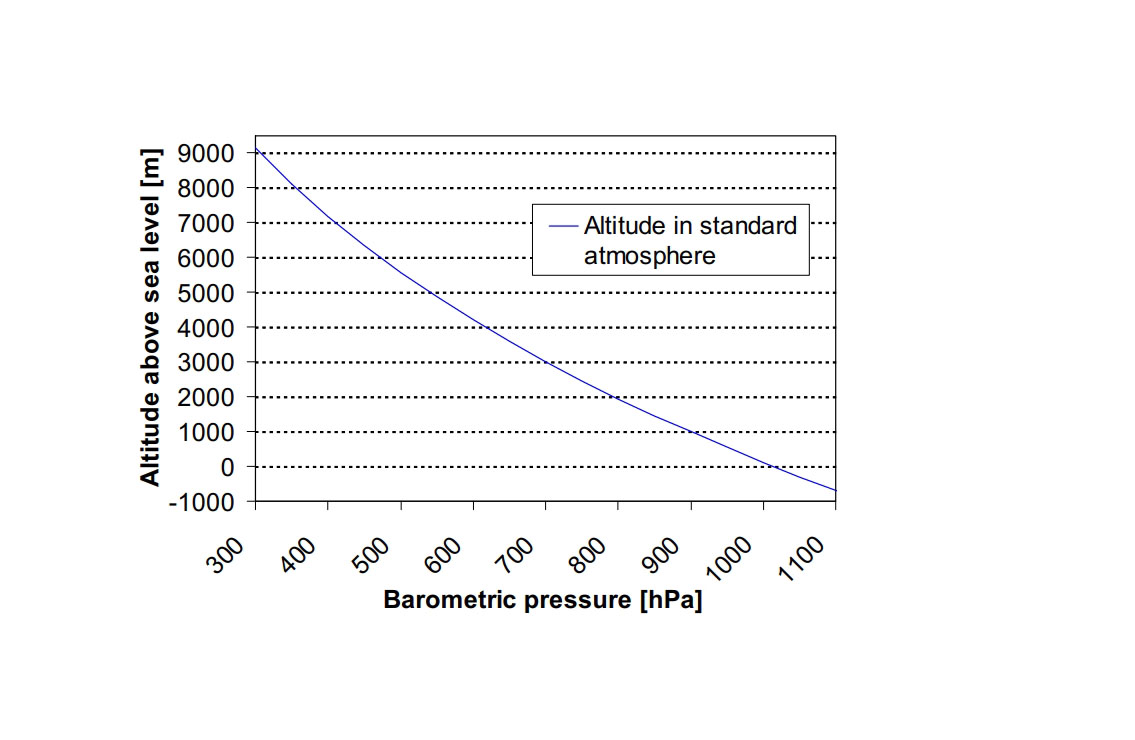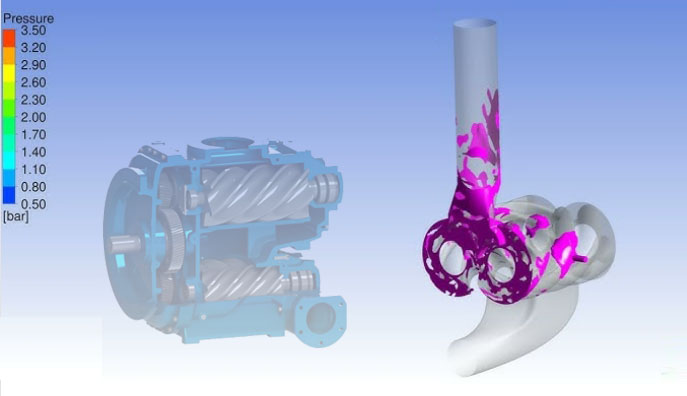In the actual project cases, we will encounter different working conditions under the unit conversion, in order to better judge the working parameters of the air compressor, we will use some
empirical formulas and estimates to make our selection more accurate.
1.1m³ and Nm³ conversion
We usually express volumetric flow, mainly involving three parameters "atmospheric pressure, temperature, humidity".During the units, m³ and Nm³ are very popular. Let’s start form these
two units to learn the conversion formula.
The working condition form³ and Nm³ are like these the inlet pressure of both is about 0.1MPa, and the humidity is (RH)0%, the difference is only in the temperature, m³ is 20℃, Nm³ is 0℃.
Usually, we will convert according to the following conversion formula to select the model of air compressor, let's take an example.

For example:
If there is a real gas, 10 m³ of air at a pressure of 1 standard atmosphere (101.32 kPa), a temperature of 35°C, and a humidity of 65% (RH), can you express this volumetric flow in " Nm³" and " m³" ?
Scenario 1 conversion →" Nm³"
QNm={[273×(p-ps×φ)/p]/(273+t)}}×Q
Where:
QNm= - standard working conditions “1 standard atmosphere (101.32 kPa), a temperature of 0°C, and a humidity of 0% (RH)”
p - absolute inlet pressure, kPa; (as long as the same as the p.)
p-- Absolute inlet pressure, kPa; (as long as the unit of p. can be consistent)
Ps - saturated water vapor partial pressure, kPa. listed commonly used in Table 14-17.
φ--Relative humidity, %(RH); t--Celsius temperature, ℃.
Q - volume of gas in actual state, m³.
QNm={[273×(101.32-5.627×65%)/101.32]/(273+35)}×10≈8.54Nm³
Table 14-17.
| Temperature/℃ | 10 | 15 | 20 | 25 | 30 | 35 | 40 | 45 | 50 | 55 | 60 |
| Saturation pressure/kPa | 1.228 | 1.706 | 2.339 | 3.169 | 4.246 | 5.627 | 7.381 | 9.589 | 12.34 | 15.75 | 19.93 |
Scenario 2 conversion →" m³"
Qm={[293×(p-ps×φ)/p]/(273+t)}}×Q
Qm - specified working condition “cubic meter”, “1 standard atmosphere (101.32 kPa), a temperature of 20°C, and a humidity of 0% (RH)”;
p - Absolute inlet pressure, kpa; (as long as and ps unit has been maintained)
ps - partial pressure of saturated water vapor, kpa. commonly used partial pressure of water vapor see table 14-01
φ - relative humidity, % (RH).
t - Celsius temperature, ℃.
Q - the actual state of the gas volume, m ³.
Calculate as follows:
Qm = {[293 x (101.32-5.627 x 65%)/101.32]/(273+35)}} x 10 ≈ 9.165Nm³
In the actual sizing machine, we will typically convert to the exact mechanical air displacement data to ensure that the customer's air requirements are met.
1.2 Different Altitudes, Air Flow Conversion (Air Volume Cap Estimation)

When the air compressor is used in the plateau area, the empirical formula for calculating its air flow is as below.
Q1/Q2 =ε2/ε1
where
Q1-air flow in Plains region
Q2-air flow in the plateau area
ε1-Plains region compression ratio
ε2-Plateau area compression ratio
The compression ratio is the ratio of the absolute pressures of the compressor outlet and inlet.
For example:
There is one air compressor which the power of air compressor is 110kw, exhaust pressure is 0.8MPa, volume flow rate (air flow) is 20m ³ / min.If this air compressor machine works
in plateau area with the altitude of 2000 meters above sea level. Then what the air flow in the new working condition?
(Note:2000 meters above sea level is assumed to be the atmospheric pressure of 0.085MPa, the actual calculation can check the altitude according to the atmospheric pressure on the internet)
Solution:
According to the equation Q1/Q2 = ε2/ε1
Q2 = ε1 x Q1/ε2
ε1= 0.9/0.1= 9
ε2= (0.8+0.085)/0.085= 10.4
Q2 = ε1×Q1/ε2= (20 × 9)/10.4 = 17.3 (m³/min)
If your operation site is at a higher altitude, then this formula needs to be considered to increase the air compressor's exhaust air capacity. Or you can provide the altitude data
when you purchase the air compressor and Dream engineers will help you.
1.3 Estimating Air Consumption for Multiple Demand Appliances
In practice, in an air-using occasion, there are may over one or two or even 10 different air-using appliance. These air-using appliances or tools are not used at the same time in most cases.
Here we provide an empirical formula, so you can also refer to estimate the air consumption.
Each pneumatic device in the intermittent work condition, the air source system air consumption calculation method is as below:
Q=0.5ψ×k1×k2×k3×Qmax
Where:
Qmax - the actual demand for the largest gas consumption (the gas equipment, pneumatic tools and nameplate gas consumption).
ψ - utilization factor: it takes into account all the pneumatic equipment will not be used at the same time coefficient, the empirical value of 0.95 ~ 0.65, in general,
the greater the number of pneumatic equipment, the less the simultaneous use of the situation, the smaller the value, and vice versa, the greater the value of its. 2 sets of equipment to take 0.95,
4 sets of equipment to take 0.9, 6 sets of equipment to take 0.85, 8 sets of equipment to take 0.95. 0.85, 8 sets of equipment to take 0.8, 10 sets of equipment to take 0.65.
k1 - leakage coefficient, the value of the range of 1.2 ~ 1.5.
k2 - standby coefficient, the value of 1.2 ~ 1.6.
k3 - unevenness coefficient. It is considered in the gas supply system according to the average consumption of gas calculated by the existence of uneven factors, to ensure its maximum use and set,
the value range of 1.2 ~ 1.4.
1.4 Estimation of oil consumption of an oil-injected air compressor

There are an air compressor with a power of 250 kW, an exhaust pressure of 0.8 MPa, a air flow of 40 m³/min. Assuming that and an oil content of 3 ppm, so how many oil will be consumed
consume during 1,000 hours of operation theoretically?
A few tips:
ppm is the abbreviation for parts per million, which is expressed in parts per million (a few) or known as millions of.
ppm is the abbreviation of parts per million, which means parts per million or million. It is divided into mass ratio ppmw and volume ratio ppmv. Usually we say ppm is mass ratio
(1 millionth of 1kg is 1mg).
Solution:
Oil consumption per cubic meter per minute: 3 × 1.2 = 3.6mg/m³
(1 standard atmospheric pressure, 20 ℃, the density of air is about 1.2kg/m³, 1ppm that is 1.2mg).
Then.
40m³/min fuel consumption: 40 × 3.6 = 144mg
Running 1000 hours oil consumption.
1000×60×144=8640000mg=8640g=8.64kg
Lubricating oil used to be called by volume, converted to volume.
8.64 ÷ 0.9 = 9.6L (Lubricating oil density of about 0.9)
The above is only the theoretical oil consumption, in practice it is much larger than this value (one is the oil core filtration capacity will continue to will continue to decrease,
the second is the lubricating oil will continue to deteriorate, the third is running in the variable operating conditions of many cases).
If according to 4000 hours Theoretical calculations, volume flow rate of 40m/min air compressor running oil about 38L, the reality is often the value of the
1.5~2 times. Usually, the volume flow rate of 40m/min air compressor lubricating oil total about 150L, 4000 The hourly oil consumption is 20%~40%.
Dream Compressors has been committed to the Chinese air compressor industry for 14 years, and has helped countless customers to improve and upgrade their air-using equipment,
as well as expand their new projects. We look forward to hearing from you.